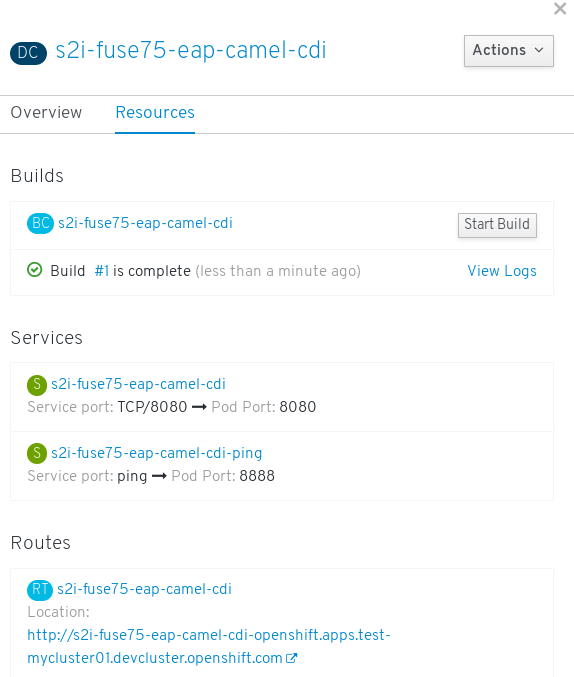Chapter 11. Developing an application for the JBoss EAP image
To develop Fuse applications on JBoss EAP, an alternative is to use the S2I source workflow to create an OpenShift project for Red Hat Camel CDI with EAP.
Prerequisites
- Ensure that OpenShift is running correctly and the Fuse image streams are already installed in OpenShift. See Getting Started for Administrators.
- Ensure that Maven Repositories are configured for fuse, see Configuring Maven Repositories.
11.1. Creating a JBoss EAP project using the S2I source workflow
To develop Fuse applications on JBoss EAP, an alternative is to use the S2I source workflow to create an OpenShift project for Red Hat Camel CDI with EAP.
Procedure
Add the
viewrole to the default service account to enable clustering. This grants the user theviewaccess to thedefaultservice account. Service accounts are required in each project to run builds, deployments, and other pods. Enter the followingocclient commands in a shell prompt:oc login -u developer -p developer oc policy add-role-to-user view -z default
oc login -u developer -p developer oc policy add-role-to-user view -z defaultCopy to Clipboard Copied! Toggle word wrap Toggle overflow View the installed Fuse on OpenShift templates.
oc get template -n openshift
oc get template -n openshiftCopy to Clipboard Copied! Toggle word wrap Toggle overflow Enter the following command to create the resources required for running the Red Hat Fuse 7.5 Camel CDI with EAP quickstart. It creates a deployment config and build config for the quickstart. The information about the quickstart and the resources created is displayed on the terminal.
Copy to Clipboard Copied! Toggle word wrap Toggle overflow -
Navigate to the OpenShift web console in your browser (https://OPENSHIFT_IP_ADDR, replace
OPENSHIFT_IP_ADDRwith the IP address of the cluster) and log in to the console with your credentials (for example, with usernamedeveloperand password,developer). -
In the left hand side panel, expand
Home. ClickStatusto view theProject Statuspage. All the existing applications in the selected namespace (for example, openshift) are displayed. Click
s2i-fuse75-eap-camel-cdito view theOverviewinformation page for the quickstart.
Click the
Resourcestab and then click the link displayed in the Routes section to access the application.
The link has the form http://s2i-fuse75-eap-camel-cdi-OPENSHIFT_IP_ADDR. This shows a message like the following in your browser:
Hello world from 172.17.0.3
Hello world from 172.17.0.3Copy to Clipboard Copied! Toggle word wrap Toggle overflow You can also specify a name using the name parameter in the URL. For example, if you enter the URL, http://s2i-fuse75-eap-camel-cdi-openshift.apps.cluster-name.openshift.com/?name=jdoe, in your browser you see the response:
Hello jdoe from 172.17.0.3
Hello jdoe from 172.17.0.3Copy to Clipboard Copied! Toggle word wrap Toggle overflow -
Click
View Logsto view the logs for the application. To shut down the running pod,
-
Click the
Overviewtab to return to the overview information page of the application. -
Click the
 icon next to Desired Count. The
icon next to Desired Count. The Edit Countwindow is displayed. - Use the down arrow to scale down to zero to stop the pod.
-
Click the
11.2. Structure of the JBoss EAP application
You can find the source code for the Red Hat Fuse 7.5 Camel CDI with EAP example at the following location:
https://github.com/wildfly-extras/wildfly-camel-examples/tree/wildfly-camel-examples-5.2.0.fuse-720021/camel-cdi
https://github.com/wildfly-extras/wildfly-camel-examples/tree/wildfly-camel-examples-5.2.0.fuse-720021/camel-cdiThe directory structure of the Camel on EAP application is as follows:
Where the following files are important for developing a JBoss EAP application:
- pom.xml
- Includes additional dependencies.
11.3. JBoss EAP quickstart templates
The following S2I templates are provided for Fuse on JBoss EAP:
| Name | Description |
|---|---|
|
JBoss Fuse 7.5 Camel A-MQ with EAP ( | Demonstrates using the camel-activemq component to connect to an AMQ message broker running in OpenShift. It is assumed that the broker is already deployed. |
|
Red Hat Fuse 7.5 Camel CDI with EAP ( | Demonstrates using the camel-cdi component to integrate CDI beans with Camel routes. |
|
Red Hat Fuse 7.5 CXF JAX-RS with EAP ( | Demonstrates using the camel-cxf component to produce and consume JAX-RS REST services. |
|
Red Hat Fuse 7.5 CXF JAX-WS with EAP ( | Demonstrates using the camel-cxf component to produce and consume JAX-WS web services. |
|
Red Hat Fuse 7.5 Camel JPA + MySQL (Ephemeral) with EAP | Demonstrates how to connect a Camel application with Red Hat Fuse on EAP to a MySQL database and expose a REST API. This example creates two containers, one container to run as a MySQL server, and another running the Camel application which acts as as a client to the database. |